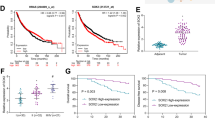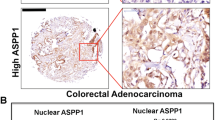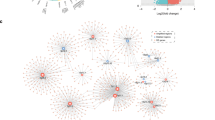Abstract
P53 inactivation by p53 mutation and E6 oncoprotein has a crucial role in human carcinogenesis. DDX3 has been shown to be a target of p53. In this study, we hypothesized that DDX3 loss by p53 inactivation may promote tumor malignancy and poor patients’ outcome. Mechanically, DDX3 loss by p53 knockdown and E6 overexpression was observed in A549 lung cancer cells. Conversely, DDX3 expression was markedly elevated by wild-type (WT) p53 ectopic expression in p53-null H1299 cells, E6-knockdown TL-1 lung cancer and SiHa cervical cancer cells. Interestingly, DDX3 loss promotes soft-agar growth and invasive capability; however, both capabilities were suppressed by DDX3 overexpression. We next expected that DDX3 loss might result in Slug-suppressed E-cadherin expression via decreased MDM2-mediated Slug degradation. As expected, MDM2 transcription is suppressed by DDX3 loss via decreased SP1 binding activity to the MDM2 promoter. Consequently, Slug expression was elevated by the reduction of MDM2 because of DDX3 loss, and E-cadherin expression was suppressed by Slug. Consistent observations in the correlation of DDX3 loss with MDM2, Slug and E-cadherin were seen in lung tumors from lung cancer patients. In addition, patients with low-DDX3 tumors had poorer survival and relapse than patients with high-DDX3 tumors. In conclusion, we suggest that DDX3 loss by p53 inactivation via MDM2/Slug/E-cadherin pathway promotes tumor malignancy and poor patient outcome.
This is a preview of subscription content, access via your institution
Access options
Subscribe to this journal
Receive 50 print issues and online access
$259.00 per year
only $5.18 per issue
Buy this article
- Purchase on Springer Link
- Instant access to full article PDF
Prices may be subject to local taxes which are calculated during checkout






Similar content being viewed by others
References
Soussi T, Beroud C . Assessing TP53 status in human tumours to evaluate clinical outcome. Nat Rev Cancer 2001; 1: 233–240.
Flatt PM, Polyak K, Tang LJ, Scatena CD, Westfall MD, Rubinstein LA et al. P53-dependent expression of PIG3 during proliferation, genotoxic stress, and reversible growth arrest. Cancer Lett 2000; 156: 63–72.
Yuan A, Yu CJ, Luh KT, Kuo SH, Lee YC, Yang PC . Aberrant p53 expression correlates with expression of vascular endothelial growth factor mRNA and interleukin-8 mRNA and neoangiogenesis in non-small-cell lung cancer. J Clin Oncol 2002; 20: 900–910.
Olivier M, Eeles R, Hollstein M, Khan MA, Harris CC, Hainaut P . The IARC TP53 database: new online mutation analysis and recommendations to users. Hum Mutat 2002; 19: 607–614.
Haupt Y, Maya R, Kazaz A, Oren M . Mdm2 promotes the rapid degradation of p53. Nature 1997; 387: 296–299.
Kubbutat MH, Jones SN, Vousden KH . Regulation of p53 stability by Mdm2. Nature 1997; 387: 299–303.
Freedman DA, Levine AJ . Nuclear export is required for degradation of endogenous p53 by MDM2 and human papillomavirus E6. Mol Cell Biol 1998; 18: 7288–7293.
Thomas M, Pim D, Banks L . The role of the E6–p53 interaction in the molecular pathogenesis of HPV. Oncogene 1999; 18: 7690–7700.
Cheng YW, Wu MF, Wang J, Yeh KT, Goan YG, Chiou HL et al. Human papillomavirus 16/18 E6 oncoprotein is expressed in lung cancer and related with p53 inactivation. Cancer Res 2007; 67: 10686–10693.
Hingorani SR, Wang L, Multani AS, Combs C, Deramaudt TB, Hruban RH et al. Trp53R172H and KrasG12D cooperate to promote chromosomal instability and widely metastatic pancreatic ductal adenocarcinoma in mice. Cancer Cell 2005; 7: 469–483.
Feldser DM, Kostova KK, Winslow MM, Taylor SE, Cashman C, Whittaker CA et al. Stage-specific sensitivity to p53 restoration during lung cancer progression. Nature 2010; 468: 572–575.
Junttila MR, Karnezis AN, Garcia D, Madriles F, Kortlever RM, Rostker F et al. Selective activation of p53-mediated tumour suppression in high-grade tumours. Nature 2010; 468: 567–571.
Shih JY, Yang PC . The EMT regulator slug and lung carcinogenesis. Carcinogenesis 2011; 32: 1299–1304.
Thiery JP . Epithelial–mesenchymal transitions in tumour progression. Nat Rev Cancer 2002; 2: 442–454.
Nieto MA . The snail superfamily of zinc-finger transcription factors. Nat Rev Mol Cell Biol 2002; 3: 155–166.
Bolos V, Peinado H, Perez-Moreno MA, Fraga MF, Esteller M, Cano A . The transcription factor Slug represses E-cadherin expression and induces epithelial to mesenchymal transitions: a comparison with Snail and E47 repressors. J Cell Sci 2003; 116: 499–511.
Hajra KM, Chen DY, Fearon ER . The SLUG zinc-finger protein represses E-cadherin in breast cancer. Cancer Res 2002; 62: 1613–1618.
Wang SP, Wang WL, Chang YL, Wu CT, Chao YC, Kao SH et al. P53 controls cancer cell invasion by inducing the MDM2-mediated degradation of Slug. Nat Cell Biol 2009; 11: 694–704.
Muller PA, Vousden KH, Norman JC . P53 and its mutants in tumor cell migration and invasion. J Cell Biol 2011; 192: 209–218.
Chang PC, Chi CW, Chau GY, Li FY, Tsai YH, Wu JC et al. DDX3, a DEAD box RNA helicase, is deregulated in hepatitis virus-associated hepatocellular carcinoma and is involved in cell growth control. Oncogene 2006; 25: 1991–2003.
Chao CH, Chen CM, Cheng PL, Shih JW, Tsou AP, Lee YH . DDX3, a DEAD box RNA helicase with tumor growth-suppressive property and transcriptional regulation activity of the p21waf1/cip1 promoter, is a candidate tumor suppressor. Cancer Res 2006; 66: 6579–6588.
Sekiguchi T, Kurihara Y, Fukumura J . Phosphorylation of threonine 204 of DEAD-box RNA helicase DDX3 by cyclin B/cdc2 in vitro. Biochem Biophys Res Commun 2007; 356: 668–673.
Botlagunta M, Vesuna F, Mironchik Y, Raman A, Lisok A, Winnard P Jr et al. Oncogenic role of DDX3 in breast cancer biogenesis. Oncogene 2008; 27: 3912–3922.
Wu DW, Liu WS, Wang J, Chen CY, Cheng YW, Lee H . Reduced p21(WAF1/CIP1) via alteration of p53-DDX3 pathway is associated with poor relapse-free survival in early-stage human papillomavirus-associated lung cancer. Clin Cancer Res 2011; 17: 1895–1905.
Al Moustafa AE, Kassab A, Darnel A, Yasmeen A . High-risk HPV/ErbB-2 interaction on E-cadherin/catenin regulation in human carcinogenesis. Curr Pharm Des 2008; 14: 2159–2172.
Laurson J, Khan S, Chung R, Cross K, Raj K . Epigenetic repression of E-cadherin by human papillomavirus 16 E7 protein. Carcinogenesis 2010; 31: 918–926.
Boulenouar S, Weyn C, Van Noppen M, Moussa Ali M, Favre M, Delvenne PO et al. Effects of HPV-16 E5, E6 and E7 proteins on survival, adhesion, migration and invasion of trophoblastic cells. Carcinogenesis 2010; 31: 473–480.
Matthews K, Leong CM, Baxter L, Inglis E, Yun K, Backstrom BT et al. Depletion of Langerhans cells in human papillomavirus type 16-infected skin is associated with E6-mediated down regulation of E-cadherin. J Virol 2003; 77: 8378–8385.
Knappskog S, Bjornslett M, Myklebust LM, Huijts PE, Vreeswijk MP, Edvardsen H et al. The MDM2 promoter SNP285C/309G haplotype diminishes Sp1 transcription factor binding and reduces risk for breast and ovarian cancer in Caucasians. Cancer Cell 2011; 19: 273–282.
Cheng YW, Lee H, Shiau MY, Wu TC, Huang TT, Chang YH . Human papillomavirus type 16/18 up-regulates the expression of interleukin-6 and antiapoptotic Mcl-1 in non-small cell lung cancer. Clin Cancer Res 2008; 14: 4705–4712.
Cheng YW, Wu TC, Chen CY, Chou MC, Ko JL, Lee H . Human telomerase reverse transcriptase activated by E6 oncoprotein is required for human papillomavirus-16/18-infected lung tumorigenesis. Clin Cancer Res 2008; 14: 7173–7179.
Bremnes RM, Veve R, Hirsch FR, Franklin WA . The E-cadherin cell–cell adhesion complex and lung cancer invasion, metastasis, and prognosis. Lung Cancer 2002; 36: 115–124.
Yoshino I, Kase S, Yano T, Sugio K, Sugimachi K . Expression status of E-cadherin and alpha-, beta-, and gamma-catenins in thymoma. Ann Thorac Surg 2002; 73: 933–937.
Barak Y, Lupo A, Zauberman A, Juven T, Aloni-Grinstein R, Gottlieb E et al. Targets for transcriptional activation by wild-type p53: endogenous retroviral LTR, immunoglobulin-like promoter, and an internal promoter of the mdm2 gene. Cold Spring Harb Symp Quant Biol 1994; 59: 225–235.
Chien WP, Wong RH, Cheng YW, Chen CY, Lee H . Associations of MDM2 SNP309, transcriptional activity, mRNA expression, and survival in stage I non-small-cell lung cancer patients with wild-type p53 tumors. Ann Surg Oncol 2010; 17: 1194–1202.
Shiota M, Izumi H, Onitsuka T, Miyamoto N, Kashiwagi E, Kidani A et al. Twist and p53 reciprocally regulate target genes via direct interaction. Oncogene 2008; 27: 5543–5553.
Coissard CJ, Besson G, Polette MC, Monteau M, Birembaut PL, Clavel CE . Prevalence of human papillomaviruses in lung carcinomas: a study of 218 cases. Mod Pathol 2005; 18: 1606–1609.
Simen-Kapeu A, Surcel HM, Koskela P, Pukkala E, Lehtinen M . Lack of association between human papillomavirus type 16 and 18 infections and female lung cancer. Cancer Epidemiol Biomarkers Prev 2010; 19: 1879–1881.
Klein F, Amin Kotb WF, Petersen I . Incidence of human papilloma virus in lung cancer. Lung Cancer 2009; 65: 13–18.
Cheng YW, Hsieh LL, Lin PP, Chen CP, Chen CY, Lin TS et al. Gender difference in DNA adduct levels among nonsmoking lung cancer patients. Environ Mol Mutagen 2001; 37: 304–310.
Koshiol J, Rotunno M, Gillison ML, Van Doorn LJ, Chaturvedi AK, Tarantini L et al. Assessment of human papillomavirus in lung tumor tissue. J Natl Cancer Inst 2011; 103: 501–507.
zur Hausen H . Papillomaviruses and cancer: from basic studies to clinical application. Nat Rev Cancer 2002; 2: 342–350.
Wu DW, Cheng YW, Wang J, Chen CY, Lee H . Paxillin predicts survival and relapse in non-small cell lung cancer by microRNA-218 targeting. Cancer Res 2010; 70: 10392–10401.
Hsu NY, Cheng YW, Chan IP, Ho HC, Chen CY, Hsu CP et al. Association between expression of human papillomavirus 16/18 E6 oncoprotein and survival in patients with stage I non-small cell lung cancer. Oncol Rep 2009; 21: 81–87.
Wu YH, Wu TC, Liao JW, Yeh KT, Chen CY, Lee H . P53 dysfunction by xeroderma pigmentosum group C defects enhance lung adenocarcinoma metastasis via increased MMP1 expression. Cancer Res 2010; 70: 10422–10432.
Drane P, Bravard A, Bouvard V, May E . Reciprocal down-regulation of p53 and SOD2 gene expression–implication in p53 mediated apoptosis. Oncogene 2001; 20: 430–439.
Yang JY, Zong CS, Xia W, Wei Y, Ali-Seyed M, Li Z et al. MDM2 promotes cell motility and invasiveness by regulating E-cadherin degradation. Mol Cell Biol 2006; 26: 7269–7282.
Lim SO, Kim HS, Quan X, Ahn SM, Kim H, Hsieh D et al. Notch1 binds and induces degradation of Snail in hepatocellular carcinoma. BMC Biol 2011; 9: 83.
Lim SO, Kim H, Jung G . P53 inhibits tumor cell invasion via the degradation of snail protein in hepatocellular carcinoma. FEBS Lett 2010; 584: 2231–2236.
Jiang M, Milner J . Selective silencing of viral gene expression in HPV-positive human cervical carcinoma cells treated with siRNA, a primer of RNA interference. Oncogene 2002; 21: 6041–6048.
Yoshinouchi M, Yamada T, Kizaki M, Fen J, Koseki T, Ikeda Y et al. In vitro and in vivo growth suppression of human papillomavirus 16-positive cervical cancer cells by E6 siRNA. Mol Ther 2003; 8: 762–768.
Uchikado Y, Natsugoe S, Okumura H, Setoyama T, Matsumoto M, Ishigami S et al. Slug expression in the E-cadherin preserved tumors is related to prognosis in patients with esophageal squamous cell carcinoma. Clin Cancer Res 2005; 11: 1174–1180.
Zhang K, Chen D, Jiao X, Zhang S, Liu X, Cao J et al. Slug enhances invasion ability of pancreatic cancer cells through upregulation of matrix metalloproteinase-9 and actin cytoskeleton remodeling. Lab Invest 2011; 91: 426–438.
Ramasami S, Kerr KM, Chapman AD, King G, Cockburn JS, Jeffrey RR . Expression of CD44v6 but not E-cadherin or beta-catenin influences prognosis in primary pulmonary adenocarcinoma. J Pathol 2000; 192: 427–432.
Retera JM, Leers MP, Sulzer MA, Theunissen PH . The expression of beta-catenin in non-small-cell lung cancer: a clinicopathological study. J Clin Pathol 1998; 51: 891–894.
Sulzer MA, Leers MP, van Noord JA, Bollen EC, Theunissen PH . Reduced E-cadherin expression is associated with increased lymph node metastasis and unfavorable prognosis in non-small cell lung cancer. Am J Respir Crit Care Med 1998; 157: 1319–1323.
Acknowledgements
This work was jointly supported by grants from the National Health Research Institute (NHRI96-TD-G-111-006; NHRI97-TD-G-111-006) and the National Science Council (NSC-96-2628-B-040-002-MY3; DOH100-TD-C-111-005) of Taiwan, ROC.
Author information
Authors and Affiliations
Corresponding author
Ethics declarations
Competing interests
The authors declare no conflict of interest.
Additional information
Supplementary Information accompanies this paper on the Oncogene website
Supplementary information
Rights and permissions
About this article
Cite this article
Wu, DW., Lee, MC., Wang, J. et al. DDX3 loss by p53 inactivation promotes tumor malignancy via the MDM2/Slug/E-cadherin pathway and poor patient outcome in non-small-cell lung cancer. Oncogene 33, 1515–1526 (2014). https://doi.org/10.1038/onc.2013.107
Received:
Revised:
Accepted:
Published:
Issue Date:
DOI: https://doi.org/10.1038/onc.2013.107
Keywords
This article is cited by
-
DDX3X: structure, physiologic functions and cancer
Molecular Cancer (2021)
-
Absence of EpCAM in cervical cancer cells is involved in slug induced epithelial-mesenchymal transition
Cancer Cell International (2021)
-
The DEAD-box protein family of RNA helicases: sentinels for a myriad of cellular functions with emerging roles in tumorigenesis
International Journal of Clinical Oncology (2021)
-
Risk prediction models for dementia constructed by supervised principal component analysis using miRNA expression data
Communications Biology (2019)
-
Human papillomavirus and lung cancer: an overview and a meta-analysis
Journal of Cancer Research and Clinical Oncology (2019)



